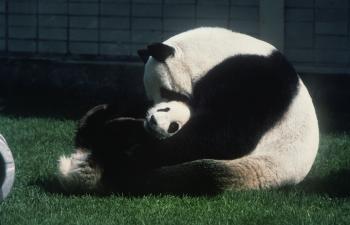Today is Giant Panda cub Bao Bao’s third birthday, and yesterday her little brother, Bei Bei, turned one. This marks the first time in the forty-four years of panda conservation at the National Zoo that there have been two healthy cubs in residence at the zoo at the same time, but that’s not for lack of trying.

 In 1972, Hsing-Hsing and Ling-Ling arrived at the National Zoo as gifts from China to the United States. That same year, Dr. Devra Kleiman, a conservation zoologist, began working at the zoo, focusing mainly on species conservation of Giant Pandas and Golden Lion Tamarins. At the time, very little was known about the social and reproductive habits of the Giant Panda. With the help of a team of volunteers, Kleiman began conducting around-the-clock observations and keeping very detailed notes on the pandas’ behaviors. She noticed that, despite popular belief, pandas in captivity were not solitary creatures, and keeping them apart made for unsuccessful mating attempts during the very narrow female fertile period. This observation resulted in a change to the panda enclosure that allowed Ling-Ling and Hsing-Hsing to interact more frequently.
In 1972, Hsing-Hsing and Ling-Ling arrived at the National Zoo as gifts from China to the United States. That same year, Dr. Devra Kleiman, a conservation zoologist, began working at the zoo, focusing mainly on species conservation of Giant Pandas and Golden Lion Tamarins. At the time, very little was known about the social and reproductive habits of the Giant Panda. With the help of a team of volunteers, Kleiman began conducting around-the-clock observations and keeping very detailed notes on the pandas’ behaviors. She noticed that, despite popular belief, pandas in captivity were not solitary creatures, and keeping them apart made for unsuccessful mating attempts during the very narrow female fertile period. This observation resulted in a change to the panda enclosure that allowed Ling-Ling and Hsing-Hsing to interact more frequently.
In 1983, Ling-Ling and Hsing-Hsing successfully mated for the first time, and the first pregnancy watch began. On July 20, 1983, observers noticed signs of nest building and a general sense of discomfort from Ling-Ling. They were even able to observe a few contractions. She gave birth to her first panda cub in the early morning hours of July 21st, but unfortunately, the joy over the birth of the newborn would be short lived. The cub succumbed to pneumonia about three hours later. Over the next seven years, Ling-Ling gave birth three more times, once to twins, but none of the cubs survived more than four days. While mourning these losses, Kleiman and her team tried to learn from them in order to encourage successful births in the future. By 1988, the birth management plan included steps to treat the cub with antibodies derived from Hsing-Hsing shortly after birth, since it was determined that the cubs were not getting sufficient antibodies from Ling-Ling during nursing.
 In 2000, the National Zoo received two more pandas, Mei Xiang and Tian Tian, following the deaths of Ling-Ling and Hsing-Hsing in 1992 and 1999, respectively. Although hopes for a baby panda were high with this new pair, the first several mating and artificial insemination attempts were once again unsuccessful. Finally, in 2005, all of the efforts paid off and Mei Xiang gave birth to a giant panda cub on July 9th, and this one survived. The cub was a boy named Tai Shan, and he was the first giant panda cub born at the National Zoo who thrived. In fact, per the agreement with China, Tai Shan was sent to the Wolong Nature Reserve in 2010, shortly after his fifth birthday, where he is participating in the reserve’s breeding program.
In 2000, the National Zoo received two more pandas, Mei Xiang and Tian Tian, following the deaths of Ling-Ling and Hsing-Hsing in 1992 and 1999, respectively. Although hopes for a baby panda were high with this new pair, the first several mating and artificial insemination attempts were once again unsuccessful. Finally, in 2005, all of the efforts paid off and Mei Xiang gave birth to a giant panda cub on July 9th, and this one survived. The cub was a boy named Tai Shan, and he was the first giant panda cub born at the National Zoo who thrived. In fact, per the agreement with China, Tai Shan was sent to the Wolong Nature Reserve in 2010, shortly after his fifth birthday, where he is participating in the reserve’s breeding program.
Despite all that researchers at the National Zoo had learned from Ling-Ling and Mei Xiang’s pregnancies, it would be seven years before Mei Xiang gave birth again, and another year after that before she produced a cub that survived long term. That cub was named Bao Bao, and just two years later, her brother Bei Bei was born, marking the first time at the National Zoo that back-to-back pregnancies resulted in healty giant panda cubs. Since Giant Panda mothers typically do not have a fertile period during the first year of their cub’s life, the earliest we could expect to see another baby panda born at the National Zoo is next summer. So hopefully this trend of success will continue, and this time next year we will be in the throes of another panda pregnancy watch!
Related Resources
- Giant Pandas at the Smithsonian's National Zoo, Smithsonian National Zoological Park
- Panda-monium!, The Bigger Picture, Smithsonian Institution Archives
- The Archival Legacy of Devra Kleiman, The Bigger Picture, Smithsonian Institution Archives
Produced by the Smithsonian Institution Archives. For copyright questions, please see the Terms of Use.

Leave a Comment